SEARCH
FAQ: Can you tell me about some of the special materials and techniques used in motorcycle apparel?
There are a lot of different specialty materials used in the making of motorcycle gear, some of it for increased protection, others for greater comfort in the different weather conditions you might encounter while out on the road. We get a lot of questions about these different materials and thought we’d try to provide a brief overview of many of them and what they’re commonly used for.
 ABS: Thermoplastic (often polycarbonate) used in the production of injection molded helmet shells and motorcycle trim pieces. Used for its hard-wearing, scratch- and impact resistance qualities. Tip: Do not add stickers or repaint ABS helmets or trim pieces because solvents in the glue or paint can damage them.
ABS: Thermoplastic (often polycarbonate) used in the production of injection molded helmet shells and motorcycle trim pieces. Used for its hard-wearing, scratch- and impact resistance qualities. Tip: Do not add stickers or repaint ABS helmets or trim pieces because solvents in the glue or paint can damage them.
 AirGuard™: Highly abrasion-and tear resistant hollow fiber polyamide fabric featuring tiny air pockets, which insulate against fluctuation in ambient temperature to improve wearer comfort with no weight penalty. It is also water repellent and windproof, easy to clean and quick drying. Scorpion has been using this fabric for the windproof and/or waterproof liners for some of their jackets and pants.
AirGuard™: Highly abrasion-and tear resistant hollow fiber polyamide fabric featuring tiny air pockets, which insulate against fluctuation in ambient temperature to improve wearer comfort with no weight penalty. It is also water repellent and windproof, easy to clean and quick drying. Scorpion has been using this fabric for the windproof and/or waterproof liners for some of their jackets and pants.
 Amara: Synthetic leather made of 60% polyamide and 40% polyurethane, which is weatherproof, soft, and comfortable. It also offers excellent grip and is therefore often used on the palms of motorcycle gloves. FirstGear and Tour Master both are using this material in several of their gloves.
Amara: Synthetic leather made of 60% polyamide and 40% polyurethane, which is weatherproof, soft, and comfortable. It also offers excellent grip and is therefore often used on the palms of motorcycle gloves. FirstGear and Tour Master both are using this material in several of their gloves.
 Aramid: Aramid fibers are a class of heat-resistant and strong synthetic fibers. Aramid fibers can have a stretchy quality, so we sometimes see them used in the stretch panels in the sleeves and crotch on suits, such as those from Alpinestars. Aramid is also highly abrasion-resistant, so we’re seeing panels of this fabric used to reinforce the knees and seat of riding jeans made by Joe Rocket and Icon. Helmet manufacturers are using Aramid fibers in some of their helmet models, like the RPS-10 from HJC and the EXO-R2000 from Scorpion.
Aramid: Aramid fibers are a class of heat-resistant and strong synthetic fibers. Aramid fibers can have a stretchy quality, so we sometimes see them used in the stretch panels in the sleeves and crotch on suits, such as those from Alpinestars. Aramid is also highly abrasion-resistant, so we’re seeing panels of this fabric used to reinforce the knees and seat of riding jeans made by Joe Rocket and Icon. Helmet manufacturers are using Aramid fibers in some of their helmet models, like the RPS-10 from HJC and the EXO-R2000 from Scorpion.
 Cambrelle®: Cambrelle® is the world’s leading footwear lining with a high level of abrasion resistance and countless microscopic air pockets that allow air to circulate and add to the cushioning effect to create a constant, comfortable micro-climate around the foot. The lining transports moisture away from the foot, storing it away and releasing it back into the environment when the footwear is removed. Cambrelle® is so efficient at moisture management that it is fully capable of absorbing three-and-a-half times its own weight in moisture keeping the foot cooler, drier, and more comfortable.
It also protects the shoe itself. As it is so effective at dispersing moisture, the lining also helps to prevent staining of the upper from excess moisture and prevents the build-up of bacteria that can cause mildew, rot and odor.
Cambrelle®: Cambrelle® is the world’s leading footwear lining with a high level of abrasion resistance and countless microscopic air pockets that allow air to circulate and add to the cushioning effect to create a constant, comfortable micro-climate around the foot. The lining transports moisture away from the foot, storing it away and releasing it back into the environment when the footwear is removed. Cambrelle® is so efficient at moisture management that it is fully capable of absorbing three-and-a-half times its own weight in moisture keeping the foot cooler, drier, and more comfortable.
It also protects the shoe itself. As it is so effective at dispersing moisture, the lining also helps to prevent staining of the upper from excess moisture and prevents the build-up of bacteria that can cause mildew, rot and odor.
 Carbon/Kevlar: Carbon fiber fabrics are characterized by a combination of light weight, high strength and high stiffness. Kevlar® is the DuPont trade name for a unique fiber called Aramid. Low density, high tensile strength and excellent toughness distinguish Aramid fibers. Aramid fibers are used in composites to provide lightweight, strong laminates with excellent resistance to fatigue and impact damage as well as good wear resistance. Carbon/Kevlar fabrics are composite weaves of both materials, often seen in knuckle protectors on high end race gloves, such as those made by Held and Alpinestars.
Carbon/Kevlar: Carbon fiber fabrics are characterized by a combination of light weight, high strength and high stiffness. Kevlar® is the DuPont trade name for a unique fiber called Aramid. Low density, high tensile strength and excellent toughness distinguish Aramid fibers. Aramid fibers are used in composites to provide lightweight, strong laminates with excellent resistance to fatigue and impact damage as well as good wear resistance. Carbon/Kevlar fabrics are composite weaves of both materials, often seen in knuckle protectors on high end race gloves, such as those made by Held and Alpinestars.
 Chamude®: Chamude is an artificial leather that provides the sophisticated appearance of natural leather and resolves its problems using microfibers. Using microfiber technology and special processes, this product provides fine appearance and soft touch, as well as a higher level of durability, permeability, breathability, comfort, and insulation. In addition, Chamude allows the application of a variety of colors and is lightweight enough for thickness control.
Chamude®: Chamude is an artificial leather that provides the sophisticated appearance of natural leather and resolves its problems using microfibers. Using microfiber technology and special processes, this product provides fine appearance and soft touch, as well as a higher level of durability, permeability, breathability, comfort, and insulation. In addition, Chamude allows the application of a variety of colors and is lightweight enough for thickness control.
 Clarino™: High-performance synthetic with the feel of leather: Durable and comfortable, Clarino™ has leather’s performance but is light, breathable, and always soft – even when it’s cold and wet. Highly breathable performance is perfect for active riders. Lightweight, soft, and flexible for comfort on long rides. We see this material used primarily in the palms of gloves made by some of our top manufacturers, like Alpinestars, AGV, Cortech, FirstGear, Fieldsheer and Tour Master.
Clarino™: High-performance synthetic with the feel of leather: Durable and comfortable, Clarino™ has leather’s performance but is light, breathable, and always soft – even when it’s cold and wet. Highly breathable performance is perfect for active riders. Lightweight, soft, and flexible for comfort on long rides. We see this material used primarily in the palms of gloves made by some of our top manufacturers, like Alpinestars, AGV, Cortech, FirstGear, Fieldsheer and Tour Master.
 Cocona®: Derived from coconut shells, Cocona® active particles enhance the performance of waterproof breathable fabrics by increasing the surface area and absorbing the energy your body produces to accelerate evaporation and breathability, keeping you dry on the inside and allowing you to stay out longer. Billions of active micro porous Cocona® particles provide 800% more surface area to spread moisture. These active particles utilize body heat to help speed up evaporation and accelerate breathability. By using the energy your body creates to speed up evaporation, you stay drier and more comfortable.
Cocona®: Derived from coconut shells, Cocona® active particles enhance the performance of waterproof breathable fabrics by increasing the surface area and absorbing the energy your body produces to accelerate evaporation and breathability, keeping you dry on the inside and allowing you to stay out longer. Billions of active micro porous Cocona® particles provide 800% more surface area to spread moisture. These active particles utilize body heat to help speed up evaporation and accelerate breathability. By using the energy your body creates to speed up evaporation, you stay drier and more comfortable.
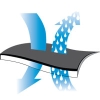 Coolmax®: Polyester fabric which keeps the wearer cool by controlling humidity and wicking moisture away from the body. It’s light, breathable, soft to the touch, easy-care and dries quickly. It is often used in helmet and garment linings, as well as in technical underwear. Both Sidi and Alpinestars use it in their hugely popular riding socks; we also sell skull caps and balaclavas that use Coolmax to keep you comfortable.
Coolmax®: Polyester fabric which keeps the wearer cool by controlling humidity and wicking moisture away from the body. It’s light, breathable, soft to the touch, easy-care and dries quickly. It is often used in helmet and garment linings, as well as in technical underwear. Both Sidi and Alpinestars use it in their hugely popular riding socks; we also sell skull caps and balaclavas that use Coolmax to keep you comfortable.
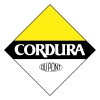 Cordura®: High quality polyamide fabric woven from precision-cut DuPont hollow fibers. Cordura® is more durable and abrasion resistant than other nylons and is particularly suited to heavy-duty use. It also has a comfortable feel and natural woven appearance. Sidi, FirstGear and Alpinestars all use it in many of their products; it’s often a component of tank bags as well.
Cordura®: High quality polyamide fabric woven from precision-cut DuPont hollow fibers. Cordura® is more durable and abrasion resistant than other nylons and is particularly suited to heavy-duty use. It also has a comfortable feel and natural woven appearance. Sidi, FirstGear and Alpinestars all use it in many of their products; it’s often a component of tank bags as well.
 d30™ Protectors: Patented intelligent shock absorbing material which remains soft and pliable during general wear, but becomes solid on sudden impact. d30™ is engineered with rate sensitive molecules which flow with you as you move, but will lock together on violent contact to absorb impact energy. The whole process occurs instantaneously and d30™ protectors will return to their original state after the impact has subsided, and can be used again. FirstGear uses this type of armor in some of their pants and Icon is using it in their Stryker armor line.
d30™ Protectors: Patented intelligent shock absorbing material which remains soft and pliable during general wear, but becomes solid on sudden impact. d30™ is engineered with rate sensitive molecules which flow with you as you move, but will lock together on violent contact to absorb impact energy. The whole process occurs instantaneously and d30™ protectors will return to their original state after the impact has subsided, and can be used again. FirstGear uses this type of armor in some of their pants and Icon is using it in their Stryker armor line.
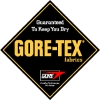
 Gore-Tex®: The original and best waterproof, windproof and breathable climate membrane. The pores in this wonder material are 20,000 times smaller than a water molecule, yet 700 times larger than a water vapor molecule, so rain can’t get in but sweat can get out. Many Sidi and TCX boots feature a Gore-Tex membrane, we also see it in Alpinestars and Held gloves.
Gore-Tex®: The original and best waterproof, windproof and breathable climate membrane. The pores in this wonder material are 20,000 times smaller than a water molecule, yet 700 times larger than a water vapor molecule, so rain can’t get in but sweat can get out. Many Sidi and TCX boots feature a Gore-Tex membrane, we also see it in Alpinestars and Held gloves.
 HiPora® is a waterproof film with polyurethane coating. Numerous micro pores are placed all over the polyurethane coating which shut out water from the outside, yet allow the moisture or warm steam from the body to exit. We frequently see gloves and boots made with HiPora®; they are waterproof, windproof and breathable all at the same time and will keep your hands and feet dry and comfortable. Cortech and Tour Master have quite a few boots and gloves with HiPora® membranes; FirstGear has used it heavily in their gloves the last couple of years.
HiPora® is a waterproof film with polyurethane coating. Numerous micro pores are placed all over the polyurethane coating which shut out water from the outside, yet allow the moisture or warm steam from the body to exit. We frequently see gloves and boots made with HiPora®; they are waterproof, windproof and breathable all at the same time and will keep your hands and feet dry and comfortable. Cortech and Tour Master have quite a few boots and gloves with HiPora® membranes; FirstGear has used it heavily in their gloves the last couple of years.
 Kangaroo hide: Of the 48 species of kangaroo, many are protected. However, the unchecked reproduction of the largest breed has resulted in massive over-population and culls are therefore carried out under the supervision of the Australian government. Fortunately for motorcyclists, the hides make excellent rider equipment. Kangaroo hide is far more abrasion resistant than cowhide of the same thickness. This is because, unlike cows, kangaroos only sweat through their tail and therefore there are no pores in the hide. Kangaroo garments can therefore be lighter and provide more “feel”. Special tanning and drying methods mean kangaroo hide is resistant to moisture and so is less likely to lose its shape or degrade over time. Held gloves commonly use kangaroo hide and we see it in some of the high end gloves from AGV, Alpinestars and Icon.
Kangaroo hide: Of the 48 species of kangaroo, many are protected. However, the unchecked reproduction of the largest breed has resulted in massive over-population and culls are therefore carried out under the supervision of the Australian government. Fortunately for motorcyclists, the hides make excellent rider equipment. Kangaroo hide is far more abrasion resistant than cowhide of the same thickness. This is because, unlike cows, kangaroos only sweat through their tail and therefore there are no pores in the hide. Kangaroo garments can therefore be lighter and provide more “feel”. Special tanning and drying methods mean kangaroo hide is resistant to moisture and so is less likely to lose its shape or degrade over time. Held gloves commonly use kangaroo hide and we see it in some of the high end gloves from AGV, Alpinestars and Icon.
 Lorica® Lorica is a textile that has been designed to be like leather but better. It is composed of polyurethane and polyamide microfiber and the manufacturing phases are neither toxic nor harmful to man or the environment. Lorica is an innovative material that scores excellent results in bio-medical tests: the analysis carried out in specialized centers confirm that Lorica is a non-allergenic, non-sensitive and non-irritating product. Where Lorica excels over leather is in the areas a motorcyclist needs – lighter weight, breathability, waterproofing and flexibility. Lorica is softer to the foot than leather and boots made from Lorica do not have to be ‘broken in’. Out of the box they are good for day-long comfort. Needless to say, boots with a Lorica upper are vegetarian friendly. Another bonus is that, unlike leather, Lorica uppers do not need ‘odor eaters’.
Lorica® Lorica is a textile that has been designed to be like leather but better. It is composed of polyurethane and polyamide microfiber and the manufacturing phases are neither toxic nor harmful to man or the environment. Lorica is an innovative material that scores excellent results in bio-medical tests: the analysis carried out in specialized centers confirm that Lorica is a non-allergenic, non-sensitive and non-irritating product. Where Lorica excels over leather is in the areas a motorcyclist needs – lighter weight, breathability, waterproofing and flexibility. Lorica is softer to the foot than leather and boots made from Lorica do not have to be ‘broken in’. Out of the box they are good for day-long comfort. Needless to say, boots with a Lorica upper are vegetarian friendly. Another bonus is that, unlike leather, Lorica uppers do not need ‘odor eaters’.
 McFit® Technology
This stands for Maximum Comfort Fit. This patented technology is based on the liner, membrane and outer shell being laminated together. Maximum Comfort gives a more flexible glove and therefore a better feel. In producing gloves, it used to be difficult to join the function membrane and the outer shell while achieving waterproof protection that did not wear out or split. But Maximum Comfort FIT technology ensures that the liner, membrane and outer material stay tightly bonded. The technology is also used in gloves without membranes, with the liner being bonded to the outer material for a more flexible glove. No more pulling your hand out of the glove to find the liner still attached to your hand, then having to try and reinsert the liner into the glove.
McFit® Technology
This stands for Maximum Comfort Fit. This patented technology is based on the liner, membrane and outer shell being laminated together. Maximum Comfort gives a more flexible glove and therefore a better feel. In producing gloves, it used to be difficult to join the function membrane and the outer shell while achieving waterproof protection that did not wear out or split. But Maximum Comfort FIT technology ensures that the liner, membrane and outer material stay tightly bonded. The technology is also used in gloves without membranes, with the liner being bonded to the outer material for a more flexible glove. No more pulling your hand out of the glove to find the liner still attached to your hand, then having to try and reinsert the liner into the glove.
 Nomex®: Developed by DuPont in the early 1960s, Nomex® is a flame resistant fiber that is useful across a wide variety of industries – from firefighter turnout gear to transformer insulation. We see it primarily used on the lower legs of pants to protect them (and you) from contact with hot pipes. Tour Master uses it for some of their rain pants; it’s ideal for use on lighter weight fabric like that used for rain gear.
Nomex®: Developed by DuPont in the early 1960s, Nomex® is a flame resistant fiber that is useful across a wide variety of industries – from firefighter turnout gear to transformer insulation. We see it primarily used on the lower legs of pants to protect them (and you) from contact with hot pipes. Tour Master uses it for some of their rain pants; it’s ideal for use on lighter weight fabric like that used for rain gear.

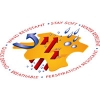 Pittards® leather: The hairsheep is a cross between a sheep and a goat only found in the mountains of some African countries. Its hide is soft and comfortable, like goatskin, but it has a more dense – and therefore hardwearing – structure which is ideal for glove making. Pittards® hairsheep leather is world renowned for its supple durability and responsive feel. The WR 100X finish takes it up a notch as it provides permanent water resistance, its beautiful appearance is maintained over time. It also has excellent sweat resistance for longer lasting gloves and it is very breathable for optimum comfort. Held, FirstGear, Alpinestars, Icon, AGV and Joe Rocket have many glove styles that use Pittards® leather in the palm.
Pittards® leather: The hairsheep is a cross between a sheep and a goat only found in the mountains of some African countries. Its hide is soft and comfortable, like goatskin, but it has a more dense – and therefore hardwearing – structure which is ideal for glove making. Pittards® hairsheep leather is world renowned for its supple durability and responsive feel. The WR 100X finish takes it up a notch as it provides permanent water resistance, its beautiful appearance is maintained over time. It also has excellent sweat resistance for longer lasting gloves and it is very breathable for optimum comfort. Held, FirstGear, Alpinestars, Icon, AGV and Joe Rocket have many glove styles that use Pittards® leather in the palm.
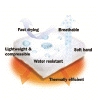 Primaloft® uses unique fibers and technologies to create high-performance synthetic insulation that is light-weight, effective, water-resistant, and durable. It is made to insulate effectively without awkward bulk and its quick-drying hydrophobic fibers work even when wet. Held uses Primaloft® in some of their winter gloves.
Primaloft® uses unique fibers and technologies to create high-performance synthetic insulation that is light-weight, effective, water-resistant, and durable. It is made to insulate effectively without awkward bulk and its quick-drying hydrophobic fibers work even when wet. Held uses Primaloft® in some of their winter gloves.
 Reissa® is a functional fabric with breathable membrane with high sensitivity concerning weather conditions. It is an advanced textile with a highly developed specific polyurethane resin coating or membrane. This technology creates an extremely thin waterproof coating or membrane that is light weight for wearing comfort but extremely durable. It is highly resistant to rain, wind and snow while maintaining breathability. It is very flexible and has a comfortable soft touch. AGV Sport is using it in many of their textile jackets.
Reissa® is a functional fabric with breathable membrane with high sensitivity concerning weather conditions. It is an advanced textile with a highly developed specific polyurethane resin coating or membrane. This technology creates an extremely thin waterproof coating or membrane that is light weight for wearing comfort but extremely durable. It is highly resistant to rain, wind and snow while maintaining breathability. It is very flexible and has a comfortable soft touch. AGV Sport is using it in many of their textile jackets.
 schoeller®-keprotec®: Yet another space-age material from schoeller®. Gram for gram this aramid weave is five times stronger than steel and therefore offers outstanding abrasion protection and is ideal for reinforcing high-risk areas on a variety of garments, like the palm area on gloves. (Held uses this fabric frequently, especially in their winter gloves). It is also used for stretch panels, so that comfort and movement do not compromise safety. Speed and Strength is using it on their one piece suits and some of their jackets.
schoeller®-keprotec®: Yet another space-age material from schoeller®. Gram for gram this aramid weave is five times stronger than steel and therefore offers outstanding abrasion protection and is ideal for reinforcing high-risk areas on a variety of garments, like the palm area on gloves. (Held uses this fabric frequently, especially in their winter gloves). It is also used for stretch panels, so that comfort and movement do not compromise safety. Speed and Strength is using it on their one piece suits and some of their jackets.
 Stingray skin is the most abrasion resistant material that is pliant enough to be used in the manufacture of gloves. Selected styles of Held gloves feature Stingray protection on the ball of the thumb, knuckles and wrist, backed with shock absorbing gel pads in order to allow fallen riders to slide more easily with less chance of fractured limbs caused by rolling. AGV Sport has also begun using Stingray skin on their high performance gloves.
Stingray skin is the most abrasion resistant material that is pliant enough to be used in the manufacture of gloves. Selected styles of Held gloves feature Stingray protection on the ball of the thumb, knuckles and wrist, backed with shock absorbing gel pads in order to allow fallen riders to slide more easily with less chance of fractured limbs caused by rolling. AGV Sport has also begun using Stingray skin on their high performance gloves.

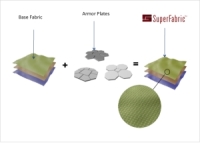 SuperFabric™: A mix of 32% polyester and 68% epoxy resin creates a super-tough material which offers full flexibility as well as extremely high cut and abrasion resistance. It is used to reinforce crash zones on riding garments and gloves. One of the big advantages of this product is how lightweight it is; it’s also extremely supple. Cortech, Held and Scorpion are some of the manufacturers using SuperFabric™ in their products.
SuperFabric™: A mix of 32% polyester and 68% epoxy resin creates a super-tough material which offers full flexibility as well as extremely high cut and abrasion resistance. It is used to reinforce crash zones on riding garments and gloves. One of the big advantages of this product is how lightweight it is; it’s also extremely supple. Cortech, Held and Scorpion are some of the manufacturers using SuperFabric™ in their products.
 Suprotect is a special open-cell, breathable PU-foam from NASA space research that is often used under hard knuckle protection shells on high end gloves. It is ideal as a comfortable absorption material for shock, impact and vibrations which is why Held is using it on many of their gloves.
Suprotect is a special open-cell, breathable PU-foam from NASA space research that is often used under hard knuckle protection shells on high end gloves. It is ideal as a comfortable absorption material for shock, impact and vibrations which is why Held is using it on many of their gloves.
 Thinsulate™: Warmth without bulk. 3M’s™ performance synthetic insulation utilizes microfibers to trap air and retain heat while maintaining an exceptionally bulk-free profile. It traps more air in less space than any other insulation – even down. Its quick-drying hydrophobic fibers absorb less than 1% of their weight in water. FirstGear, Tour Master and Alpinestars use it in many of their gloves; we also see it in thermal liners for jackets.
Thinsulate™: Warmth without bulk. 3M’s™ performance synthetic insulation utilizes microfibers to trap air and retain heat while maintaining an exceptionally bulk-free profile. It traps more air in less space than any other insulation – even down. Its quick-drying hydrophobic fibers absorb less than 1% of their weight in water. FirstGear, Tour Master and Alpinestars use it in many of their gloves; we also see it in thermal liners for jackets.








